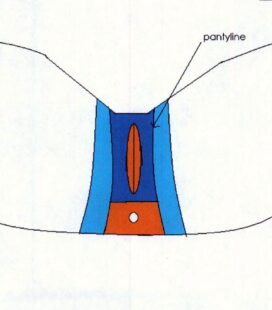As discussed in my previous blogs on aesthetic procedures for female genitalia and labiaplasty, there has been a steady increase in demand for these procedures in the last 10 years, both at my plastic surgery clinic in Toronto and internationally. As I’ve discussed previously, there are 7 areas that need to be addressed when discussing labiaplasty.
1. Pubic area (previous blog, part 1)
2. Labia Majora (previous blog, part 1)
3. Labia minora – labiaplasty (previous blog, part 1)
4. Clitoris hood reduction
5. Vagina – vaginoplasty
6. Hymen reconstruction – hymenoplasty or hymenorrphy
7. Perineum: perineoplasty
4. Clitoris hood reduction
As mentioned above, trimming alone of the labia minora can sometimes lead to a very bulky-looking clitoris hooding (also called the clitoris’ prepuce, analogous to the penis’ foreskin). When there is excessive hooding, the trimming technique is extended into the clitoris hood in a horseshoe fashion, hence the horseshoe technique. The clitoris hood can also be reduced as a solo procedure.
5. Vagina – vaginoplasty
Various causes of excessive vaginal mucosa – and laxity – exist but by far the most common is multiple childbirths. Cosmetic vaginoplasty (sometimes wrongly referred to a colporrhaphy) consists of tightening the inner component of the vaginal canal and the ‘Kegel’ muscles by excising longitudinally some mucosa, tightening and closing the defect. The ideal situation is to detect where the loose tissue is located and to perform the excision in that area. So one can talk about an anterior, posterior, lateral or bilateral lateral colporrhaphy or tightening repair.
Cosmetic vaginal surgery (tightening procedure) should always be accompanied with a detailed psychosexual history-taking along with a clear expectation after surgery. Although the technique is relatively simple, there is no guarantee that sexual pleasure and performance will be heightened with this procedure.
6. Hymen reconstruction – hymenoplasty or hymenorrphy
The demand has been also increasing over the last 5 years despite the controversies in the public opinion. In today’s world, we create larger breasts with implants, we rejuvenate a face with a facelift, we remove excessive hooding on the lids, etc., all techniques used in plastic surgery that aim at going back in time, to some extent. The hymenorraphy is not much different and it gives a woman the same advantage – power – as a man has.
The technique of hymenorraphy aims at recreating the partial membrane that was present prior to the first penetration. One can use the old remnants of hymen yet, those remnants tend to be hard and fibrosed and may not bleed at the next post-procedure intercourse. It is best to create new fresh vascularized flaps and close partially the opening with those new flaps, usually posteriorly. Although no bleeding is guaranteed at the next penetration, there is a 80-90% possibility that there will be a small stain at the next intercourse.
7. Perineum cosmetic repair: perineoplasty
Perineum refers to the area between the pubic bone and the coccyx so for the females, it includes the vulva, the peri-anal area and the diamond-shaped space in between. That area is often traumatized with child birth and with an episiotomy (a surgical cut to enlarge the birth canal for larger or difficult babies, at time of delivery). That area may require repair, hence a perineoplasty.
In summary, those procedures have a high-satisfaction rate, are usually performed on healthy patients, and it is definitively part of the plastic surgeon’s ability, both aesthetically and technically.
by Dr. Marc DuPere












